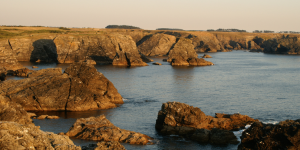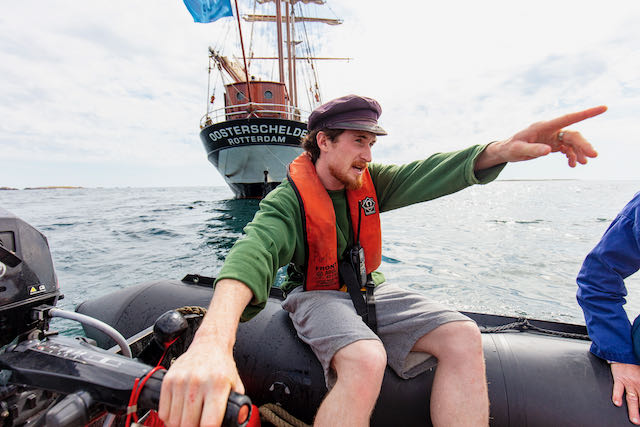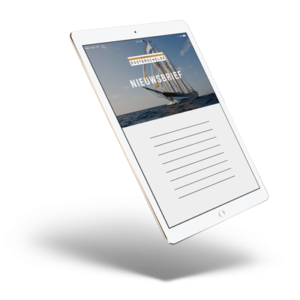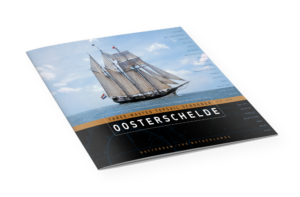14 Dec Update by Ruth
14 December 2022
News
It is just past 8PM and the Oosterschelde is flying along the Portuguese coast, already south of the famous surfing spot at Nazare. The waves are 3-4m high with white horses, there is a strong SW wind and we make our way south at 8 knots. It is still cold on deck but already we are at 39oN and can feel the warmer winds and anticipate the finer weather to come.
It was only 9 days ago, on Tuesday 6th December, that this group of twenty people, crew and guest crew, convened on the ships deck inside the Leuvehaven in Rotterdam and after introductions and coffee, waved goodbye to family, friends and well-wishers and set off under a cold clear blue December sky. The Nieuwe Leuvebrug and Erasmusbrug lifted at 1300 and 1330, respectively, to let us pass and the Oosterschelde set off on her current adventure. As the ship made its way down river, the guest crew tumbled into their allocated cabins, unpacking sailing boots and salopettes, thermal layers, extra socks, snoods, hats, gloves and sailing jackets – everything needed imminently for the cold days and nights ahead. The shorts, sandals and shades were also carefully unpacked and stowed for sunnier days we know will come. Initially, there are fire drills and alarm bells as crews gather at the muster stations on deck, we put on and check life vests, run through the safety protocols and guest crew are allocated into one of three watches.
Later that afternoon, the Oosterschelde emerges from the river into the North Sea and for the next 72 hours, with very cold, but very favourable NE winds, the ship files west, through the Straits of Dover and along the south shore of England at @ 8 knots. It is a very fast passage and comfortable sailing, despite the bitter cold. Almost exactly three days later, on Friday afternoon, we pass Falmouth and turn south for the Bay of Biscay. There are numerous weather systems with strong southerly winds headed our way and we would prefer not to encounter these in the open waters of the bay, so we sail and motor-sail south, towards La Coruna in Northern Spain, before eventually rounding the corner of NW Spain and anchoring just outside the harbour of the small Galician town of Muxia, just after 0100 on Sunday night / Monday morning. There may have been a beer or two shared among the guest crew to celebrate our first port of call, but everyone soon retired for a good night’s sleep after almost seven days at sea. Apart, that is, from the crew on anchor watch, which proved essential as it turned out early Monday morning when the strong winds we sought to avoid arrived in force.
There was a day ashore in the lovely harbour town of Muxia for those that fancied it. A short dinghy ride inside the harbour, followed by a quick hike up the hill behind the 14th Century Igrexa de Santa María de Muxía church, and you were rewarded with fabulous views across the peninsula. The panoramic view encompassed the wild seas battering the west shore of the peninsula, across the roofs the town, down to the marina and the sheltered fishing harbour on the eastern shore, and to the Oosterschelde just at anchor outside. A short coastal walk north leads to the lighthouse at Punta de Barca, marking the southern entrance to the bay, and here too is the famous church at Santuario da Virxe da Barca, familiar to all the mariners over the ages that have passed through these often-treacherous waters. Returning to the town via the exposed western side of the peninsula we see local fishermen not the rocks at low tide collecting goose barnacles, a Galician tradition and local delicacy. There was lunch at a local restaurant, followed by a trip to the supermarket, to pick up anything essential or desirable before a 5PM dinghy came to collect the shore crew and return us to the ship.
After an early dinner, it was eventually anchors aweigh at 2030 and once more to the sea, as Captain Jan spots a weather window and we motor sail south for two days along the coasts of Spain and Portugal. Outside Lisbon on this night we meet high seas, very heavy squalls, sideways rain and lightning, sails are dropped as we weather the storms, but soon we pick up the strong westerlies that are forecast, reset the sails and once again head toward the warmer climes of the Canary Islands, our destination on this leg of the trip. In the meantime, red watch is at the helm, the moon is hidden, the stars are many and the Oosterschelde sails on.







